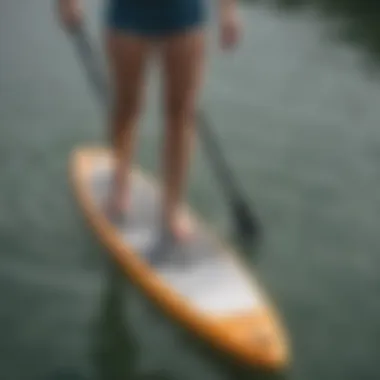Choosing the Perfect Paddle Size for SUP


Intro
Navigating the world of stand-up paddleboarding (SUP) can be both thrilling and challenging. One significant factor that influences your experience on the water is your choice of paddle size. Selecting the right size can either make your paddling sessions feel effortless or turn them into a grueling exercise. In this article, we will delve into the nuances of paddle size selection and the various elements that play a part in this decision.
Not all paddles are created equal. The factors of height, paddling style, and paddle design should be considered for an optimal experience. Whether you glide on a tranquil lake or fight ocean waves, understanding these dynamics can dramatically improve your performance. The idea here is to empower you with sound knowledge, leading to informed choices that can elevate your adventures.
This guide aims to clarify misconceptions, provide vital tips, and set you on the right path—whether you’re new to SUP or you've been paddling for years. So, tighten your grip, it’s time to explore the essentials of picking the right paddle size.
Gear Essentials
Understanding Paddle Sizes
When it comes to choosing a paddle, the length is arguably the most critical factor. For most paddlers, a general rule of thumb is that your paddle should be approximately 6-8 inches taller than you when you're standing. But keep in mind that this can vary based on your paddling style.
For instance:
- Recreational Paddlers: If you're in it for leisurely exploration, a longer paddle might suit you. It provides better reach, which is ideal for cruising.
- Performance Paddlers: Conversely, if you’re all about speed and technique, you may prefer a slightly shorter paddle to enhance your stroke efficiency.
Top Picks for Watersports Equipment
- Bamboo Paddles: These are lightweight and eco-friendly. They offer a unique feel on the water.
- Carbon Fiber Paddles: Known for their strength and stiffness, making them suitable for those who paddle hard and fast.
- Fiberglass Paddles: A budget-friendly option that still provides decent performance and durability.
Each type of paddle comes with its own set of pros and cons. Assess your priorities—weight, cost, and durability come into play when making a selection.
Maintenance and Care Tips for Gear
Taking proper care of your paddle is crucial for longevity. Here are some straightforward tips:
- Rinse After Use: Always rinse your paddle with fresh water after each outing, especially if you’ve been in saltwater.
- Store Properly: Keep it away from direct sunlight, as UV rays can degrade the materials over time.
- Inspect Regularly: Look for signs of wear and tear, and make necessary repairs to avoid costly replacements down the line.
The right paddle can significantly improve your enjoyment of stand-up paddleboarding.
Ending
In summary, understanding paddle size and type can make a world of difference in your overall experience on the water. By taking the time to assess your unique needs and preferences, you’ll be well-positioned to make an educated choice that will enhance both your performance and enjoyment in the great outdoors. Stay tuned for more insights in the subsequent sections!
Understanding Paddle Size in SUP
Selecting the right paddle size in stand-up paddleboarding (SUP) is crucial for anyone looking to enhance their experience on the water. An appropriate paddle ensures not only effective movement through water but also helps maintain proper posture and reduces fatigue. The right length allows paddlers to transfer power efficiently while minimizing strain on the shoulders and arms. Without proper paddle sizing, even the most skilled paddler can find themselves struggling, which is far from ideal when you’re trying to enjoy a day on the water.
The importance of paddle size goes beyond just comfort; it's about performance. A paddle that is too short may result in inadequate leverage, leading the paddler to overexert themselves, while a paddle that's too long can cause unnecessary strain on the back and arms. By understanding the principles of paddle sizing, individuals can select equipment tailored to their personal attributes and paddling style, ultimately transforming their paddleboarding outings into enjoyable and effective sessions.
The Importance of Paddle Size
Choosing the correct paddle size can directly impact your overall performance and enjoyment on the water. Here are some critical elements that illustrate its importance:
- Efficiency: Proper paddle length allows for optimal stroke efficiency. Each stroke can become more powerful and precise, particularly when making sharp turns or navigating through waves.
- Physical Health: A well-sized paddle minimizes the risk of strain and injury. Over time, using the wrong size can lead to chronic issues in the wrists and shoulders, which are not easy to recover from.
- Confidence on the Water: Those new to SUP can feel more secure and stable with the right paddle. The paddle is a key tool for maintaining balance, and a size that fits allows for more comfortable and confident paddling.
In short, understanding paddle size is more than just a technical detail; it's about crafting an enjoyable and sustainable paddleboarding experience.
Common Misconceptions About Paddle Size
Many paddlers, especially newcomers, hold some misconceptions about paddle size that can lead to unwise choices. Here are a few:
- "One Size Fits All": A common belief is that a single paddle can suit everyone. In reality, paddle size should be tailored to the individual’s height, paddling style, and even the type of board they are using.
- Longer Is Always Better: Some assume that a longer paddle always provides better performance, but this isn't the case. A paddle that's too long can hinder effectiveness and lead to overexertion.
- Specialized Paddles Aren't Necessary: Many people think they can use any paddle for any type of paddling, but specialized paddles are designed for specific activities like racing, touring, or recreational use. Choosing the right paddle for the right activity can significantly enhance the experience.


Understanding these misconceptions is vital. What feels comfortable in the store may not reflect real-world performance.
Gaining insight into these myths prepares paddlers to make informed decisions, ultimately guiding them towards a better paddleboarding journey. By addressing these common errors in thinking, individuals can save themselves potential discomfort and frustration in their adventures.
Key Factors in Determining Paddle Length
Choosing the right paddle length involves several critical factors that directly affect your performance and comfort while paddleboarding. Key elements get to the heart of paddle size, including the paddler's height, paddling style, and the specific type of stand-up paddleboard being used. Understanding these components is crucial, not only for improving your paddling efficiency but also for enhancing your overall experience on the water.
Height of the Paddler
The height of the paddler is perhaps the most straightforward consideration when determining paddle length. Typically, taller paddlers require longer paddles, while shorter individuals benefit from shorter paddles. A common guideline suggests adding about 8 to 10 inches to your height for the optimal paddle length. For example, if you're 5 feet 8 inches tall, a paddle around 86 inches long might serve you well.
However, this measurement can vary based on other factors like the type of paddling you're doing. If you're racing, you might want to go a bit longer for increased reach with each stroke, while more casual paddlers may prefer a shorter paddle for easier handling. It's essential not to just rely on the numbers; personal comfort plays a significant role here.
Paddling Style Considerations
Paddling style can significantly affect your choice of paddle length. Different techniques provide various benefits. For example, those who prefer a high-angle paddling style – where the blade is held more vertically – may opt for a shorter paddle length. This stance allows for a more powerful stroke but with less reach.
Conversely, if you're practicing a low-angle style, where the paddle is held at a less steep angle, a longer paddle will enhance your glide and efficiency, making it a great option for longer trips or races. Individual paddling characteristics also matter. If you’re particularly aggressive or relaxed in your approach, you need to adjust the paddle size accordingly.
Type of Stand-Up Paddleboard
Not all stand-up paddleboards are created equal, and understanding the type you are using can markedly influence your paddle length decision. All-around boards, for instance, typically pair best with versatile paddle sizes, since they cater to various styles and environments.
On the other hand, racing boards, usually narrower and designed for speed, may be complemented by a longer paddle that allows for a more extended reach in the stroke. Moreover, surf SUPs require a different approach, as shorter paddles can provide enhanced maneuverability in waves. Knowing your board type leads you to a paddle that feels right at home.
"A well-sized paddle is like a finely tuned instrument; it plays an essential role in the symphony of your paddleboarding experience."
The right paddle complements your personal style while maximizing your SUP capabilities. In short, pay heed to your height, paddling style, and the board used; every factor ties together to help you select a paddle that leaves no room for regrets. By understanding these elements, you can ensure that your time on the water is productive and enjoyable.
Measuring Paddle Length
Measuring paddle length is a fundamental step for stand-up paddleboarders seeking to maximize their performance on the water. The right paddle size can profoundly impact efficiency, comfort, and overall enjoyment while paddling. When paddlers invest time in measuring and selecting the appropriate paddle length, they enhance their stability and speed, leading to a more rewarding experience on the water. In this section, we'll explore several key aspects of measuring paddle length, ensuring that paddlers of all experience levels can make informed choices.
Using Height as a Baseline
Your height serves as a critical benchmark when determining the necessary paddle length. Generally, the taller you are, the longer the paddle should be. A commonly cited guideline suggests that the paddle length should ideally fall between 8 to 10 inches taller than your height. For instance, if you're 5 feet 10 inches, a paddle length of around 86 to 88 inches would be reasonable. However, personal paddling style and comfort can dictate these numbers somewhat.
Using height as a baseline provides a solid starting point but isn’t set in stone. Consider your flexibility and paddling technique. A shorter paddle may give better control if you prefer a more relaxed, all-around style. On the flip side, if you’re aggressively racing or seeking to maximize your reach per stroke, opting for a longer paddle could be beneficial. This initial measurement can help filter down your options effectively.
Different Methods of Measurement
There are various methods to measure paddle length beyond merely relying on height. Some paddlers prefer a more hands-on approach using their current paddling set-up. Here are several techniques you can employ:
- Static Method: Stand the paddle upright next to you, ensuring that the blade is planted firmly on the floor or ground. The top of the handle should ideally reach your chin or nose.
- Arm Reach Method: Spread your arms laterally, much like you’re about to start paddling. Adjust the paddle's length until it comfortably meets your top hand with your other hand extended down the shaft. This method emphasizes how the paddle will feel while you're in action.
- Trial and Error: If you have access to multiple paddles, try each one while standing on your board. Subtle differences may significantly influence your comfort and efficiency.
The right paddle length can make or break your experience, so it’s worth taking the time to find your perfect fit.
Adjustability Features
In the world of stand-up paddleboarding, adjustable paddles have gained popularity for their versatility. They enable paddlers to tweak their paddle length according to their specific needs. Here’s why adjustable paddles can be a great option:
- Personalization: These paddles permit quick adjustments, making it simple for multiple users of different heights or styles to enjoy the same paddleboard without needing several distinct paddles.
- Ease of Storage and Transport: Collapsible paddles can be reduced in size, allowing for hassle-free transport. This feature can be especially appealing for those venturing to various locations or managing limited storage.
- Cost Efficiency: Investing in an adjustable paddle can save you money in the long run. Instead of buying different paddles for varied conditions or paddlers, one adjustable paddle can do the trick.
When considering an adjustable paddle, ensure you understand how the locking mechanism works. This will guarantee safety and prevent any abrupt changes in length while you're out on the water.
Types of Paddles and Their Impact on Size


When it comes to stand-up paddleboarding, the paddle is as crucial as the board itself. It's the key connection you have with the water. Therefore, understanding the various types of paddles and how they can affect your size choices seems imperative. Each paddle offers different features that impact maneuverability, speed, and comfort. Choosing the right one can either enhance your experience or lead to fatigue and frustration. High-quality paddles can make paddling more efficient, while the wrong choice can turn a lovely day on the water into a chore.
Material Considerations
One of the first things to consider when selecting a paddle is the material it’s made from. Paddles can be crafted from several different materials, each offering its own pros and cons. For instance, aluminum paddles tend to be on the heavier side, which can lead to tired arms after a long day on the water. While budget-friendly, they might not provide the best experience for serious paddlers.
On the other hand, fiberglass paddles are a step up. They are lighter and more durable than aluminum but still have some weight, which can be limiting for long-distance paddling.
Then we have carbon fiber paddles. These come with a higher price tag but offer excellent performance. Their lightweight nature allows for effortless paddling, helping to reduce strain over extended sessions. Comprehensive analysis of material choice boils down to weighing priorities surrounding weight, cost, and durability.
Blade Shape and Size
The next essential factor is the blade shape and size. Paddle blades can vary widely and often dictate how efficiently you can paddle. Larger blades can generate more power with each stroke, which is great for racing or swiftly navigating through rough waters. But a bigger blade can also cause fatigue, especially for newer paddlers or those who prefer leisurely cruising on calm lakes.
Meanwhile, narrow blades can offer a more gentle and smoother stroke, providing better control for paddlers focused on techniques, like yoga or fishing on their SUP. It’s a balancing act: understanding your needs based on where you paddle and your paddling style will guide you toward the right blade. A few considerations to keep in mind include:
- Your skill level and physical strength
- The type of waterways whether they're flat or choppy
- The distance you plan to cover
Shaft Flexibility
The flexibility of the paddle shaft also plays a pivotal role in how the paddle performs in action. A stiffer shaft transfers energy effectively from your paddle stroke to the water, enhancing speed. However, a more flexible shaft can absorb shock, delivering a smoother experience over choppy seas.
Choosing the right level of shaft flexibility can depend on your paddling style. If you're often tackling rough waters or prefer a more aggressive paddling style, you might lean towards a stiffer option. Conversely, if leisurely paddling is more your jam, you might appreciate the comfort of a flexible shaft. Additionally, paddles offer various lengths and choices of handle types, ensuring there's a model that perfectly suits varied preferences.
Overall, understanding the types of paddles and how their specifics relate to size is essential for enhancing your stand-up paddleboarding experience. It might also be beneficial to test a few different paddles, if possible, to see what feels right in your hands.
Remember, comfort and performance go hand in hand. Choosing the right paddle is key to enjoying your time on the water.
Choosing the Right Paddle for Your Needs
When selecting a paddle for stand-up paddleboarding (SUP), understanding your individual needs is paramount. The right paddle can make or break your experience on the water. It’s not just about grabbing the most aesthetically pleasing or the priciest item off the shelf. It is essential to analyze the various paddles available and determine how they align with your goals, physical characteristics, and style of paddling. This section delves into the specific elements, benefits, and considerations when choosing the right paddle, tailored to different paddlers' experiences.
Beginners vs. Experienced Paddlers
For newcomers to SUP, the choices can be overwhelming. A wider blade might seem appealing, as it offers more surface area for catching the water, which can inspire confidence. However, this can lead to fatigue more quickly, especially if the paddler doesn’t have the rhythm yet.
Conversely, experienced paddlers often prefer a longer, narrower blade that allows for quicker strokes and less resistance when pushing through the water. They understand how their technique impacts efficiency and can choose a paddle that matches their skill level. Here are some key points to ponder:
- Beginners: Look for a paddle that is lightweight and has a steady grip. Comfort matters greatly here.
- Experienced: Consider a paddle with a higher-quality material and flexibility. You can adjust the length to fine-tune your stroke.
Keeping your skill level in mind when choosing a paddle ensures that your experience will be positive, regardless if you are just starting or looking to refine your technique.
Touring and Racing Considerations
When it comes to touring or racing, the paddle selection can significantly impact your performance. Racing paddles tend to be longer and designed for speed, which can mean sacrificing some comfort for efficiency. They’re typically lighter as well, helping to conserve energy over long distances.
For touring, however, comfort is key. You’ll want a paddle that offers enough support for extended use without strains or sore muscles. Factors such as the paddle's weight, grip, and flexibility come into play here:
- Lightweight Materials: Carbon fiber is often favored in racing for its superior strength-to-weight ratio.
- Blade Width: A narrower blade can minimize drag, making it ideal for speedy races.
- Length: Opt for something adjustable or specific to the height for comfort without too much stretching.
Choosing the right paddle is pivotal when paddling for long distances or in races, impacting your overall performance and enjoyment.
Recreational Paddling Choices
For recreational paddlers, the choice leans more towards versatility. These paddles do not have to fit a strict set of criteria. Comfort and ease are paramount, allowing for leisurely outings away from racing pressures.


For this group, consider:
- Adjustable Paddles: Perfect for families or groups of varying heights.
- Material: Either plastic or aluminum can suffice without breaking the bank; the main goal is sustained fun on the water.
- Blade Shape: Go for a medium-sized blade that isn’t too aggressive but still provides a good stroke. A wider stance can be more comfortable for most users.
Ultimately, the best recreational paddle allows for enjoyment without the intricacies of performance-focused designs. Comfort, ease, and adaptability should guide your choices.
Remember, the right paddle isn't just an accessory; it's the connection between you and the water.
By considering your unique paddling context—whether you're just starting, heading out for a leisurely day, or pushing your limits in a race—you can ensure that your paddle choice enhances your experience. Engaging with your paddling community can also offer invaluable insights as you navigate through your options.
Maintaining Your Paddle
Keeping your stand-up paddleboard paddle in good shape is essential. Just like a finely tuned instrument, maintaining your paddle can drastically enhance your overall performance in the water. It’s not just about aesthetics; proper care leads to durability and efficiency. When you consider the conditions paddles endure—like saltwater, sun exposure, and the occasional bump against a rock—regular maintenance emerges as a no-brainer.
In a nutshell, your paddle's longevity contributes to your paddleboarding experience. Paddles that aren't well cared for can lead to fatigue during those long paddles or, worse, potential injuries due to equipment failure. Knowing how to clean, store, and maintain this essential piece of equipment is therefore critical for any serious paddler.
Cleaning and Care
Taking a bit of time to clean your paddle after use is worth its weight in gold. Letting saltwater or muddy water dry on your paddle can lead to corrosion or degradation of materials over time. Here's how you can keep your paddle in tip-top shape:
- Rinse Immediately: After each use, rinse your paddle with fresh water. This simple act washes away debris and prevents salt or dirt from settling in.
- Mild Soap: Use a mild dish soap and a soft sponge for deeper cleaning. This helps in removing any stubborn grime without scratching the paddle surface.
- Inspect for Damage: Regularly check for any nicks, cracks, or wear. Small defects can quickly turn into bigger issues if not addressed sooner rather than later.
Regular upkeep of your paddle not only preserves its functionality but also ensures your safety while paddling out on the lakes and oceans.
- Dry Properly: Make sure to dry your paddle completely before storing it. Standing water can encourage mold growth and worsen material degradation over time.
- Waxing for Protection: Occasionally, consider applying a light layer of wax to the blade for added protection against the elements. Just be cautious to avoid wax build-up that may impact performance.
Storage Tips
How you store your paddle can make all the difference in its lifespan. Proper storage keeps your paddle safe from warping, breakage, or damage due to environmental factors. Here are some effective storage tips:
- Horizontal Positioning: If possible, store the paddle horizontally. This arrangement reduces stress on the shaft and prevents the paddle from warping over time.
- Avoid Heat: Make sure to store your paddle away from direct sunlight or heat sources. High temperatures can affect the materials and lead to fading or structural weakening.
- Use Paddle Bags: Consider investing in a paddle bag for added protection during transport or long-term storage. These bags are often padded and can help fend off scratches or dents.
- Keep It Dry: Store your paddle in a dry area. Humidity can lead to rust on metal components or degradation of certain materials used in paddles.
By adhering to these cleaning and storage guidelines, your paddle will not only perform better but will also maintain its value over time. It’s all about treating your paddle with respect, and in return, it will be your reliable companion on countless watery adventures.
Ending and Next Steps
Selecting the right paddle size is more than just a choice — it's about elevating your entire stand-up paddleboarding experience. A well-tuned paddle that fits your specific needs can make all the difference between a frustrating outing and a peaceful glide across the water. Ultimately, this article highlights the varied elements you should consider, such as height, paddling style, and the type of board you use. The right paddle not only enhances performance but also boosts confidence on the water.
As you wrap your mind around the complexities of paddle selection, remember that this process isn't a one-time deal. Changes in your skill level, preferences, or even the conditions you paddle in might lead you to reassess your choice of paddle. Never hesitate to adapt your gear to your evolving needs. You might find that what feels ideal today may need updates in the future, perhaps when you gain more experience or explore different paddleboarding styles.
Reassessing Your Paddle Choice Periodically
Revisiting your paddle choice every now and then is key for sustained enjoyment and performance. Just like any sport, stand-up paddleboarding is about growth, both in skill and in experience. When you first started, a certain paddle might have been just right for you, but as you evolve, so will your needs.
Here are some indicators that it might be time to reassess your paddle:
- Skill Progression: If you've moved from a beginner to an intermediate level, you may need a paddle that offers better efficiency and speed.
- New Techniques: Embracing different paddling styles can demand specific paddle lengths or designs.
- Physical Changes: Gaining or losing height can affect your comfort level as you paddle.
It’s quite useful to periodically check in with both your personal comfort and performance metrics. If you feel fatigued more quickly or notice a decrease in your paddling speed, that’s a sign. Stay aware of how your paddle interacts with your body and board, it might be time for a change.
Engaging with the Paddleboarding Community
Joining the broader paddleboarding community provides further insights and perspectives that could refining your paddle decisions. Often, fellow paddleboarders become valuable sources of information. Participate in forums, visit local groups or join clubs; they can offer tips that might not come from an article.
The benefits of community engagement include:
- Hands-on Advice: First-hand experiences can guide you in understanding what paddle size, shape or material works best in various conditions.
- Product Trials: Many communities organize events where you can try different paddles without the commitment of purchase. \n- Networking: Building relationships in the paddleboarding scene could lead to mentorship, helping you excel more quickly.
"The best way to learn is by doing. Engage with others, share stories, and refine your skills along the way."
Engaging with fellow enthusiasts not only enhances your learning curve but also enriches your overall experience. Whether you are a newbie or seasoned paddler, leveraging the insights from a community can significantly elevate your performance on the water.
By keeping these considerations in mind, you’ll make sure that your paddleboarding journey remains enjoyable and rewarding.



